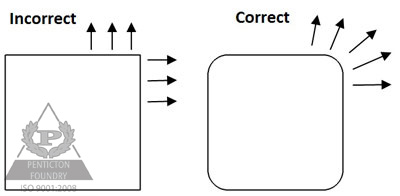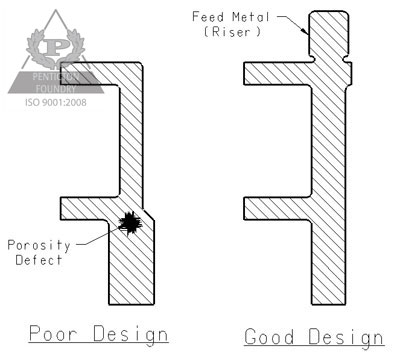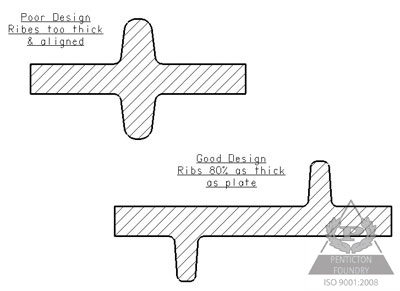Top Five Design Mistakes in Ductile Iron Castings
on April 11, 2017Ductile iron is also called spheroidal graphite iron or nodular iron. It has a number of machining advantages and outperforms steel in a variety of applications.
There are, however, critical design mistakes that can be made when creating a part in ductile iron (ASTM A536) or gray iron (ASTM A48).
Mistake 1: Sharp External Corners
Sharp, external corners cool faster and have higher and inconsistent hardness values as a result. This can affect all the mechanical properties in those areas.

Additional Resource: Read about how sharp, internal corners (and other design flaws) can seriously impact the performance of chrome white iron castings. Although this blog looks at the design mistakes in the context of chrome white iron, many of the mistakes are applicable to designing with ductile iron.
Mistake 2: Rapid Cross-Sectional Changes
As the metal shrinks, the foundry needs to feed more metal into the shrinking zone. It is important to design a part whose dimensions increase in a consistent manner toward a location that can be supplied with feed metal via a riser sleeve.

Mistake 3: Aligning Cross Members
By aligning cross members, uneven cooling is promoted which leads to hot spots, distortion and weakness. If cross members need to be brought together, the best practice is to stagger their intersection.

Mistake 4: Ribs Positioned, Sized or Shaped Incorrectly
Ribbing should not be employed on both sides of a casting if it means the ribs will line up. This creates hot spots. Instead, misalign the ribs on either side of a casting section. Ribs should be approximately 80% as thick as the section they adjoin, allowing the rib to solidify before the casting section. The shape of the rib should promote uniform cooling.

Mistake 5: Not Enough Machining Allowance
Often, designers build in a minimum amount of machining allowance, believing it will save them money. Ideally, the correct amount of machining allowance will enable the machine shop to clean up the casting and ensure it will meet the final dimensions. Sometimes too little machining allowance will leave cored holes or critical surfaces out of position and this will end up costing more money in set-up charges, or potentially in rejected parts.
Case Study: Download this free case study to learn how Penticton Foundry helped a company improve wear time through design assistance.
To learn about the ductile iron please refer to our ductile iron webpage.

